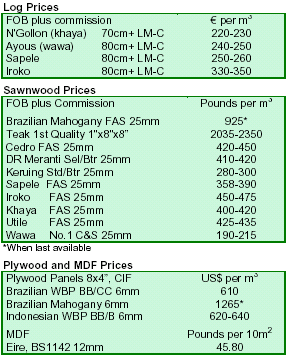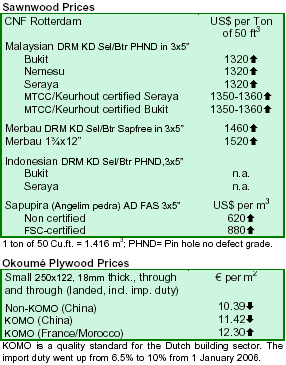|
Report
from the UK
Dollar
Exchange Rates of 23th March 2006
EU EURO 0.839
Economic prospects improve amid mixed signs
The Bank of England has kept UK interest rates on hold at 4.5% for the eighth consecutive month, and some
analysts are saying that these will likely remain unchanged for the rest of 2006. The UK current account
of the balance of payments reported a deficit of 2.6% of GDP in 2005. The deficit with the EU remained constant
while the ¡ê7.2 billion surplus with non-EU countries in 2004 turned into a ¡ê1.2 billion deficit. A comparison
carried out by Citigroup shows that the performance of the UK manufacturing sector since January 2000 has
been the weakest in the G7 group of industrialized
nations.
However economic prospects for the second quarter of 2006 have improved according to the British Chambers
of Commerce which comprises both the service and manufacturing sectors. On the other hand the British
Retail Consortium reports that sales in March fell by 1.4%, due to cold weather and the fact that Easter is late
this year. Manufacturing output fell in March and was down by 1.6% on a year earlier. Meanwhile, the British
pound has fallen 3% in the last few weeks against the euro and thus could mean higher timber product prices
from Africa and Europe in the months to come.
Another continuing worry is transport costs as oil prices reached record levels in the London market. Analysts are
again warning that prices could climb higher, and this will have a knock on effect throughout the economy.
BDO Stoy Hayward have stated that higher energy bills will push inflation up to 2.3% between April and June as
firms are forced to pass on the increases to the customer, but this is counteracted by the statement that business
confidence is at its highest level for almost a year.
Bullish signs emerge in house market
House builder Bellway has reported that a pick up in the market was now evident and their order books were very
healthy. They operate mostly in the north east of England and remain optimistic for 2006 as a whole. The latest
Nationwide Building Society survey shows that house prices rose by 1.1% in March pushing the annual rate of
increase back over 5%.
Growth of UK furniture market outpaces Europe¡¯s
UK furniture market has expanded rapidly in the recent years due to good performance in construction, high level
of optimism among consumers and low interest rates. Good performance in the property market gave a boost to
the furniture market, with consumers investing in their own property, including investment in furnishings. In
2004 and 2005 UK¡¯s private consumption grew by 3% annually, significantly higher than the European average.
Over the last 5 years home furniture consumption in the UK has registered a steadily growing trend in local
currency. UK ranks fifth among the furniture consumer countries on a world scale. In 2005, the home furniture
market in the UK exceeded euro21 billion at market prices. CSIL forecasts that furniture consumption will grow 2%
in the UK in 2006.
UK offers attractive market for contract furniture
UK is the third largest market in Europe for contract furniture and furnishings, with total sales amounting to
some euro980 million. The top 10 firms control about 12% of the market. The leading suppliers of British furniture
provide a full range of products from armchairs, sofas, chairs, tables, livingroom and bedroom furniture to
complete office furniture systems, from high-tech lighting fixtures to traditional table lamps, from outdoor
furnishings to kitchen and bathroom furniture.
Customers include architects, boutique hotels, breweries and the leisure industry, cruise boat
refurbishments, education sector, export design consultants, furniture
specifiers, golf clubs, individually owned hotels, interior designers, major architectural practices, principle interior
design practices, office furniture suppliers, other contract furniture companies, restaurants, show home developers,
smaller architectural practices, airport and shipping industry and world leading hotel groups. UK imports of
contract furnishings are worth over euro200 million, which represents 13% of total EU-15 exports. Imports of
contract furniture account for 30% of the domestic market.

*When last available
Report
from the Netherlands
Dutch timber market panorama improves
After a very difficult 2005, some timber traders hope that 2006 will bring a recovery. Pontmeyer, one of the
country¡¯s largest timber traders, faced losses of euro6.5 million in 2004 and euro3.8 million in 2005. With an
economic recovery forecast in 2006, Pontmeyer as well as other timber traders expect better results this year.
Some traders are reporting improved trade margins in the first quarter of 2006. For instance, prices for dark red
meranti (DRM) 3x5¡± KD PHND, which not long ago were as low as euro620 per m3 free delivered, are currently
at above euro740.
Traders and consumers are now more aware of supply and price developments in Peninsular Malaysia. There
remains the normal aversion to higher prices with some traders trying to knock off several euros in the
transactions. The fact is that the market panorama seems to have improved. Joineries and end users of (tropical)
hardwoods appeared to be engaged in sufficient work and the order-portfolios seem well filled for months
ahead. This is also substantiated by analysts from Rabobank Nederland and the Central Planning Bureau
who expect a robust growth of over 2.5% of the Dutch economy. The building sector has good prospects, with
analysts predicting between 70,000 and 80,000 units to be completed this year which will no doubt lead to
increased timber consumption.
Supply problems complicate stock replenishment
There is good demand for timber both (tropical) hardwoods and softwoods in the Netherlands. Supply
difficulties in Southeast Asia and Brazil, production limitations in Africa and the ban on rough sawnwood
exports from Indonesia are exerting enormous pressure on Malaysian timber. Supply possibilities of fresh DRM
are extremely limited, even for a normally common size 3x5¡±. Exporters have not much to offer and with limited
supply from sawmills in Sabah and Peninsular Malaysia, an early improvement of the situation is unlikely. The
price of 3x5¡± KD Seraya/Bukit has escalated in a very short period of time to record heights and limited
supplies are making replenishment extremely complicated. This situation is expected to continue in the
second half of April. An extra pressing factor on DRM prices is the strengthening of the Malaysian ringgit and
the Brazilian real.
With the continuous supply problems in Brazil and the
prolonged shortage of antiskid bangkirai from Indonesia, the price of the limited quantities of selangan batu has
meanwhile exceeded the $1,000 per m3 CNF-Rotterdam mark. Various alternative sources are being explored,
including bilinga from Africa, since the sales-season for antiskid decks started with spring. Consequently, the
purchase price for this fine African substitute enjoys also an upward trend for the various popular thicknesses in
the range 21 through 28mm and width of 145mm. A very popular antiskid decking is the reversible profile with
channels on one face and a fine reeded reverse.

|